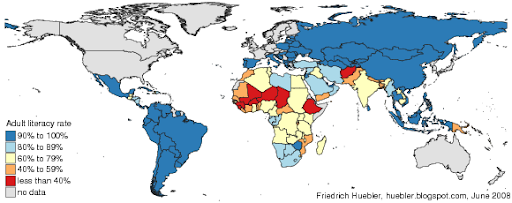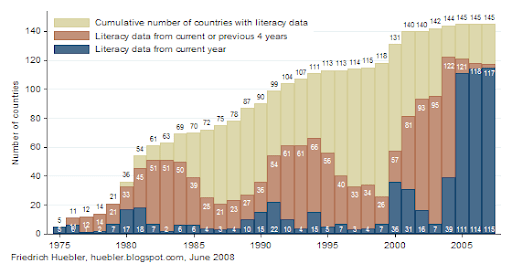A new section on troubleshooting was added to the guide to integrating Stata and external text editors. The guide describes a set of programs that can be used to run Stata commands from an external text editor. The installation of these programs is straightforward and users should not encounter any problems if the installation instructions are followed exactly. In case the programs do not work, the new section offers simple steps to track down the source of the problem. The guide to reading Statalist with Gmail was also updated to include information on a new "fixed width font" feature of Gmail.
Friedrich Huebler, 22 June 2008, Creative Commons License
Permanent URL: http://huebler.blogspot.com/2008/06/stata-guides.html
22 June 2008
15 June 2008
Adult literacy in 2007
The release of new literacy data by the UNESCO Institute for Statistics (UIS) in May 2008 provides an opportunity to update an article on adult literacy rates that was published on this site in July 2007. The adult literacy rate is the share of literate persons in the population aged 15 years and older. Compared to the previous analysis, literacy data for more countries and for more recent years is available. An article on literacy data from the UIS provides additional information on the latest UIS database.
Before the update of May, the UIS database contained adult literacy rates for 136 countries and territories. For 10 countries, the most recent data was from 2005, for 30 countries from 2004, and for 5 countries from 2003. The remaining countries had data from 2002 or earlier years.
The UIS Data Centre now offers the adult literacy rate for 145 countries and territories. For 115 countries, data from 2007 is available. The map below displays the adult literacy rate for all countries with data.
Adult literacy rates by country, 2007

Source: UNESCO Institute for Statistics, Data Centre, May 2008
The unweighted mean of the adult literacy rate is 81.2 percent. In 71 countries - including most of Eastern Europe, East and Southeast Asia, and Latin America - 90 percent or more of the adult population can read and write. The highest adult literacy rate, 99.8 percent, is reported for Cuba, Estonia and Latvia. Most countries without data are in the group of industrialized countries, where literacy rates are also likely to be above 90 percent. In 23 countries, the adult literacy rate is between 80 and 90 percent.
At the other extreme are eight countries with literacy rates below 40 percent: Mali (23.3), Chad (25.7), Afghanistan (28.0), Burkina Faso (28.7), Guinea (29.5), Niger (30.4), Ethiopia (35.9), and Sierra Leone (38.1). Another 16 countries have literacy rates between 40 and 60 percent: Benin (40.5), Senegal (42.6), Mozambique (44.4), Central African Republic (48.6), Cote d'Ivoire (48.7), Togo (53.2), Bangladesh (53.5), Pakistan (54.9), Liberia (55.5), Morocco (55.6), Bhutan (55.6), Mauritania (55.8), Nepal (56.5), Papua New Guinea (57.8), Yemen (58.9), and Burundi (59.3). Almost all of these countries are in Sub-Saharan Africa and South Asia.
Finally, the world's two largest countries in terms of population have very different literacy rates. In China, the adult literacy rate is 93.3 percent. In India, only 66 percent of the adult population can read and write.
The complete dataset with adult and youth literacy rates is available at the UIS Data Centre.
Related articles
Friedrich Huebler, 15 June 2008, Creative Commons License
Permanent URL: http://huebler.blogspot.com/2008/06/adult-literacy.html
Before the update of May, the UIS database contained adult literacy rates for 136 countries and territories. For 10 countries, the most recent data was from 2005, for 30 countries from 2004, and for 5 countries from 2003. The remaining countries had data from 2002 or earlier years.
The UIS Data Centre now offers the adult literacy rate for 145 countries and territories. For 115 countries, data from 2007 is available. The map below displays the adult literacy rate for all countries with data.
Adult literacy rates by country, 2007

Source: UNESCO Institute for Statistics, Data Centre, May 2008
The unweighted mean of the adult literacy rate is 81.2 percent. In 71 countries - including most of Eastern Europe, East and Southeast Asia, and Latin America - 90 percent or more of the adult population can read and write. The highest adult literacy rate, 99.8 percent, is reported for Cuba, Estonia and Latvia. Most countries without data are in the group of industrialized countries, where literacy rates are also likely to be above 90 percent. In 23 countries, the adult literacy rate is between 80 and 90 percent.
At the other extreme are eight countries with literacy rates below 40 percent: Mali (23.3), Chad (25.7), Afghanistan (28.0), Burkina Faso (28.7), Guinea (29.5), Niger (30.4), Ethiopia (35.9), and Sierra Leone (38.1). Another 16 countries have literacy rates between 40 and 60 percent: Benin (40.5), Senegal (42.6), Mozambique (44.4), Central African Republic (48.6), Cote d'Ivoire (48.7), Togo (53.2), Bangladesh (53.5), Pakistan (54.9), Liberia (55.5), Morocco (55.6), Bhutan (55.6), Mauritania (55.8), Nepal (56.5), Papua New Guinea (57.8), Yemen (58.9), and Burundi (59.3). Almost all of these countries are in Sub-Saharan Africa and South Asia.
Finally, the world's two largest countries in terms of population have very different literacy rates. In China, the adult literacy rate is 93.3 percent. In India, only 66 percent of the adult population can read and write.
The complete dataset with adult and youth literacy rates is available at the UIS Data Centre.
Related articles
- Literacy data from the UNESCO Institute for Statistics
- UNESCO releases data from 2007 education survey
- Adult literacy rates (article of July 2007)
- Youth literacy rates (article of July 2007)
- Disparity between adult and youth literacy
- Disparity between male and female literacy rates
- Adult literacy in Sub-Saharan Africa
Friedrich Huebler, 15 June 2008, Creative Commons License
Permanent URL: http://huebler.blogspot.com/2008/06/adult-literacy.html
Labels:
Africa,
Asia,
education,
Latin America,
literacy,
map,
statistics,
UNESCO,
world
01 June 2008
Literacy data from the UNESCO Institute for Statistics
In May 2008, the UNESCO Institute for Statistics (UIS) added new literacy data for many countries to its database at the UIS Data Centre. In total, 208 countries and territories are covered by the database. The adult literacy rate - the share of the population aged 15 years and above that can read and write - is available for 145 countries. For 115 countries, the most recent literacy data is from 2007. Historical data is also provided, going back as far as 1975, to allow the analysis of national trends in literacy.
The previous UIS database from 2007 listed the adult literacy rates for 136 countries and territories for years between 1985 and 2005. For 10 countries, the most recent data was from 2005, for 30 countries from 2004, and for 5 countries from 2003.
The graph below describes the availability of data on adult literacy in the UIS database as of late May 2008.

Source: UNESCO Institute for Statistics, Data Centre, May 2008
Related articles
Friedrich Huebler, 1 June 2008, Creative Commons License
Permanent URL: http://huebler.blogspot.com/2008/06/uis-literacy.html
The previous UIS database from 2007 listed the adult literacy rates for 136 countries and territories for years between 1985 and 2005. For 10 countries, the most recent data was from 2005, for 30 countries from 2004, and for 5 countries from 2003.
The graph below describes the availability of data on adult literacy in the UIS database as of late May 2008.
- The blue bars indicate the number of countries with data on adult literacy per year between 1975 and 2007. For each country, the adult literacy rate may be available in more than one year. The number of countries with data from a particular year is shown at the bottom of the bars, along the horizontal axis. For example, 115 countries have literacy data from 2007 and 36 countries have data from 2000.
- The brown bars show the number of countries with adult literacy rates from the current year or the previous 4 years. For example, the bar for the year 2007 indicates that 117 countries have literacy data from any year between 2003 and 2007.
- The beige bars show the cumulative number of countries with literacy data from any year since 1975. For example, in 2007, the adult literacy rate is available for a total of 145 countries and territories. The difference between the beige and brown bars in 2007 is the number of countries with the most recent literacy data from a year before 2003. The difference between the beige and blue bars in 2007 is the number of countries with the most recent data from a year before 2007.

Source: UNESCO Institute for Statistics, Data Centre, May 2008
Related articles
- UNESCO releases data from 2007 education survey
- Adult literacy rates
- Youth literacy rates
- Disparity between adult and youth literacy
- Disparity between male and female literacy rates
- Adult literacy in Sub-Saharan Africa
Friedrich Huebler, 1 June 2008, Creative Commons License
Permanent URL: http://huebler.blogspot.com/2008/06/uis-literacy.html
Labels:
education,
literacy,
statistics,
UNESCO,
world
Subscribe to:
Comments (Atom)